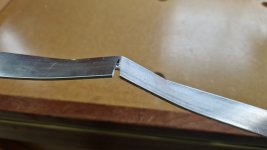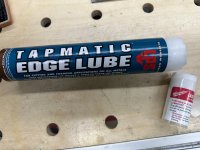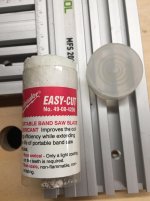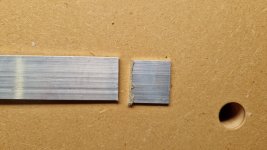Hi !
I'd like to have your opinion about this problem with my Kapex 60 (or more likely : a problem with my technique [wink]).
The reason I bought the saw is for sawing wood. And for that the saw excels with perfectly square (or angular) cuts. But sometimes, for example when making a jig, I'd like to cut some aluminum profiles (nothing fancy, just like a simple flat one, or a V- or U-profile). To do so, I bought the dedicated aluminum/plastics Festool saw blade. Now, why is it that every time I want to cut the aluminum with it, the cut results in strong kickback, bending the aluminum (please, see attached image).
It happens every time. I haven't been able to make a single clean cut. Now, I'm actually scared to try it again, as I don't want to damage the saw, or get it misaligned. I've done this probably hundreds of times on my previous miter saws without any problems but on the Kapex I somehow can't do it. I've even searched YouTube and this and other forums to see if I can find anything particular that I'm (not) doing that makes this happen, but can't find anything. I contacted Festool Belgium through their contact form but didn't get a reply (yet?).
I set the saw to speed 1 (also tried higher speed) and gently push the saw down. The profiles are firmly clamped. The mentioned alu/plastics blade is brand new and shows no visible defects.
I really hope you guys can help me getting this right. Thanks heaps in advance !
I'd like to have your opinion about this problem with my Kapex 60 (or more likely : a problem with my technique [wink]).
The reason I bought the saw is for sawing wood. And for that the saw excels with perfectly square (or angular) cuts. But sometimes, for example when making a jig, I'd like to cut some aluminum profiles (nothing fancy, just like a simple flat one, or a V- or U-profile). To do so, I bought the dedicated aluminum/plastics Festool saw blade. Now, why is it that every time I want to cut the aluminum with it, the cut results in strong kickback, bending the aluminum (please, see attached image).
It happens every time. I haven't been able to make a single clean cut. Now, I'm actually scared to try it again, as I don't want to damage the saw, or get it misaligned. I've done this probably hundreds of times on my previous miter saws without any problems but on the Kapex I somehow can't do it. I've even searched YouTube and this and other forums to see if I can find anything particular that I'm (not) doing that makes this happen, but can't find anything. I contacted Festool Belgium through their contact form but didn't get a reply (yet?).
I set the saw to speed 1 (also tried higher speed) and gently push the saw down. The profiles are firmly clamped. The mentioned alu/plastics blade is brand new and shows no visible defects.
I really hope you guys can help me getting this right. Thanks heaps in advance !




